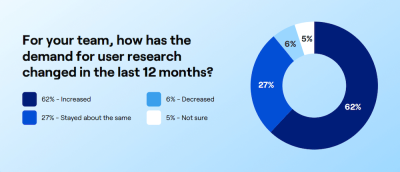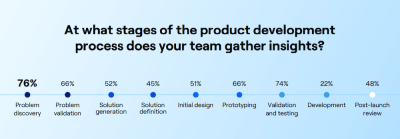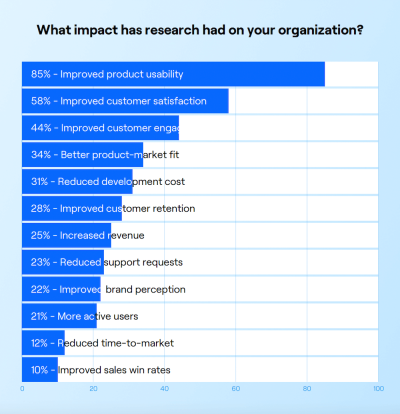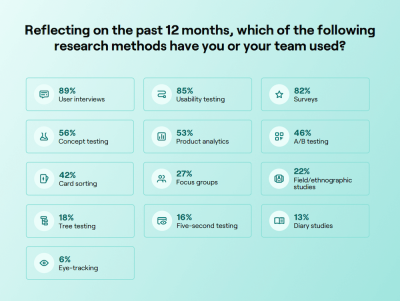Based on responses from over 1,200 product professionals, Maze’s Future of User Research Report uncovers how product teams conduct research to inform decision-making and build successful products. Learn about the top three trends defining the user research industry in 2024 and beyond.
This article has been kindly supported by our dear friends at Maze, the user research platform that empowers any company to build the right products faster by making user insights available at the speed of product development. Thank you!

How do product teams conduct user research today? How do they leverage user insights to make confident decisions and drive business growth? And what role does AI play? To learn more about the current state of user research and uncover the trends that will shape the user research landscape in 2024 and beyond, Maze surveyed over 1,200 product professionals between December 2023 and January 2024.
The Future of User Research Report summarized the data into three key trends that provide precious insights into an industry undergoing significant changes. Let’s take a closer look at the main findings from the report.
Trend 1: The Demand For User Research Is Growing
62% of respondents who took the Future of User Research survey said the demand for user research has increased in the past 12 months. Industry trends like continuous product discovery and research democratization could be contributing to this growth, along with recent layoffs and reorganizations in the tech industry.
Emma Craig, Head of UX Research at Miro, sees one reason for this increase in the uncertain times we’re living in. Under pressure to beat the competition, she sensed a “shift towards more risk-averse attitudes, where organizations feel they need to ‘get it right’ the first time.” By conducting user research, organizations can mitigate risk and clarify the strategy of their business or product.

Research Is About Learning
As the Future of User Research report found out, organizations are leveraging research to make decisions across the entire product development lifecycle. The main consumers of research are design (86%) and product (83%) teams, but it’s also marketing, executive teams, engineering, data, customer support, and sales who rely on the results from user research to inform their decision-making.
As Roberta Dombrowski, Research Partner at Maze, points out:
“At its core, research is about learning. We learn to ensure that we’re building products and services that meet the needs of our customers. The more we invest in growing our research practices and team, the higher our likelihood of meeting these needs.”

Benefits And Challenges Of Conducting User Research
As it turns out, the effort of conducting user research on a regular basis pays off. 85% of respondents said that user research improved their product’s usability, 58% saw an increase in customer satisfaction, and 44% in customer engagement.

Connecting research insights to business outcomes remains a key challenge, though. While awareness for measuring research impact is growing (73% of respondents track the impact of their research), 41% reported they find it challenging to translate research insights into measurable business outcomes. Other significant challenges teams face are time and bandwidth constraints (62%) and recruiting the right participants (60%).
Growing A Research Mindset
With the demand for user research growing, product teams need to find ways to expand their research initiatives. 75% of the respondents in the Maze survey are planning to scale research in the next year by increasing the number of research studies, leveraging AI tools, and providing training to promote research democratization.
Janelle Ward, Founder of Janelle Ward Insights, sees great potential in growing research practices, as an organization will grow a research mindset in tandem. She shares:
“Not only will external benefits like competitive advantage come into play, but employees inside the organization will also better understand how and why important business decisions are made, resulting in more transparency from leadership and a happier and more thriving work culture for everyone.”
Trend 2: Research Democratization Empowers Stronger Decision-Making
Research democratization involves empowering different teams to run research and get access to the insights they need to make confident decisions. The Future of User Research Report shows that in addition to researchers, product designers (61%), product managers (38%), and marketers (17%) conduct user research at their companies to inform their decision-making.

Teams with a democratized research culture reported a greater impact on decision-making. They are 2× more likely to report that user research influences strategic decisions, 1.8× more likely to state that it impacts product decisions, and 1.5× more likely to express that it inspires new product opportunities.
The User Researcher’s New Role
Now, if more people are conducting user research in an organization, does this mark the end of the user researcher role? Not at all. Scaling research through democratization doesn’t mean anyone can do any type of research. You’ll need the proper checks and balances to allow everyone to participate in research responsibly and effectively. The role is shifting from a purely technical to an educational role where user researchers become responsible for guiding the organization in its learning and curiosity.
To guarantee data quality and accuracy, user researchers can train partners on research methods and best practices and give them hands-on experience before they start their own research projects. This can involve having them shadow a researcher during a project, holding mock interviews, or leading collaborative analysis workshops.
Democratizing user research also means that UX researchers can open up time to focus on more complex research initiatives. While tactical research, such as usability testing, can be delegated to designers and product managers, UX researchers can conduct foundational studies to inform the product and business strategy.
User Research Tools And Techniques
It’s also interesting to see which tools and techniques product teams use to gather user insights. Maze (46%), Hotjar (26%), and UserTesting (24%) are the most widely used user research tools. When it comes to user research methods, product teams mostly turn to user interviews (89%), usability testing (85%), surveys (82%), and concept testing (56%).
According to Morgan Mullen, Lead UX Researcher at User Interviews, a factor to consider is the type of projects teams conduct. Most teams don’t change their information architecture regularly, which requires tree testing or card sorting. But they’re likely launching new features often, making usability testing a more popular research method.

Trend 3: New Technology Allows Product Teams To Significantly Scale Research
AI is reshaping how we work in countless ways, and user research is no exception. According to the Future of User Research Report, 44% of product teams are already using AI tools to run research and an additional 41% say they would like to adopt AI tools in the future.
ChatGPT is the most widely-used AI tool for conducting research (82%), followed by Miro AI (20%), Notion AI (18%), and Gemini (15%). The most commonly used research tools with AI features are Maze AI (15%), UserTesting AI (9%), and Hotjar AI (5%).
The Strengths Of AI
The tactical aspect of research is where AI truly shines. More than 60% of respondents use AI to analyze user research data, 54% for transcription, 48% for generating research questions, and 45% for synthesis and reporting. By outsourcing these tasks to artificial intelligence, respondents reported that their team efficiency improved (56%) and turnaround time for research projects decreased (50%) — freeing up more time to focus on the human and strategic side of research (35%).

The Irreplaceable Value Of Research
While AI is great at tackling time-consuming, tactical tasks, it is not a replacement for a skilled researcher. As Kate Pazoles, Head of Flex User Research at Twilio, points out, we can think of AI as an assistant. The value lies in connecting the dots and uncovering insights with a level of nuance that only UX researchers possess.
Jonathan Widawski, co-founder and CEO at Maze, sums up the growing role that AI plays in user research as follows:
“AI will be able to support the entire research process, from data collection to analysis. With automation powering most of the tactical aspects, a company’s ability to build products fast is no longer a differentiating factor. The key now lies in a company’s ability to build the right product — and research is the power behind all of this.”
Looking Ahead
With teams adopting a democratized user research culture and AI tools on the rise, the user researcher’s role is shifting towards that of a strategic partner for the organization.
Instead of gatekeeping their knowledge, user researchers can become facilitators and educate different teams on how to engage with customers and use those insights to make better decisions. By doing so, they help ensure research quality and accuracy conducted by non-researchers, while opening up time to focus on more complex, strategic research. Adopting a research mindset also helps teams value user research more and foster a happier, thriving work culture. A win-win for the organization, its employees, and customers.
No comments:
Post a Comment